The food & beverage industry is currently growing at 8.7% and is projected to be worth $8.9 trillion by 2026. This growth presents numerous opportunities and challenges for manufacturers, many of which must modernize their production lines within the next three years to remain competitive and compliant. Schneider Electric shares four modernization efforts that can help manufacturers kickstart their digital transformation and, in turn, increase efficiencies, improve product quality, reduce costs, and maximize profits.
Chanakya Gupta, Senior Offer Manager – Machine Solutions & Digital Services, Schneider Electric
The food & beverage industry is experiencing a period of incredible growth. According to Research and Markets’ 2022 report on the global food & beverage market, the industry is growing at an estimated 8.7% and is expected to reach a total value of $8.9 trillion by 2026. On one hand, we can view this trend with a massive sigh of relief considering the challenges the industry faced in 2020 due to the COVID-19 pandemic. On the other hand, this trend poses a variety of challenges for food & beverage manufacturers that aren’t ready to take advantage of the opportunities that this rapidly growing market provides or compete with those that are.
To leverage these opportunities, food & beverage manufacturers must strive to stay on top of a variety of priorities ranging from product diversification to product quality and ingredient traceability as well as output efficiency and conformance to an evolving environmental, social, and governance (ESG) regulatory landscape. It’s a lot to manage for companies of any size. According to some estimates, in order to meet today’s requirements while adhering to regulatory standards, manufacturers only have a three-year window to modernize their production lines — or risk their ability to remain competitive.
Luckily, however, we also happen to be living in an era that is continually pushing the boundaries of technology at a rate not seen since the Industrial Revolution. With so many advanced products and strategies manufacturers can adopt — often quite affordably — food & beverage manufacturers now have a generational opportunity to dive headfirst into a digital transformation that will drastically increase efficiencies, improve product quality, and, in the long term, reduce costs and maximize profit margins — and all without losing sight of any of the many priorities they must maintain in order to succeed.
Although there are a ton of opportunities for process modernization in the food & beverage industry, manufacturers at the beginning of their transformational journey can pursue just four to start making serious headway towards remaining competitive and compliant. They can update their robotic and machine controls, leverage IIoT technologies, digitize their data, and embrace ESG initiatives.

Update Robotic and Machine Controls
Nearly all major food & beverage manufacturers utilize some form of automation technology in their production lines. PLCs are one of the most widely used automation technologies in this industry and are frequently employed in production and packaging processes throughout factory assembly lines. However, traditional PLC operations have been pushed to the breaking point as product demands have increased over the past 10 years, and especially when it comes to packaging processes.
Food & beverage packaging processes arguably offer the greatest potential for automation-related cost savings and profitability. But meeting modern demands requires faster processing capabilities, several varieties of robots and sequenced motion axes, and more advanced control capabilities than traditional PLCs can provide.
Manufacturers interested in upgrading their processes to better meet modern needs have a couple of options. They can replace their PLCs with an entirely new generation of high-performance robotic and machine controllers with PLC sequence capability or upgrade their current systems with solutions including expansion modules and smart relays. Replacing traditional PLCs with high-performance, multifunctional controllers allows food & beverage manufacturers to support more complex applications at higher speeds while saving valuable factory space. These solutions require more of an upfront investment than upgrading existing PLCs with supplementary devices, but they also deliver greater production and profitability improvements. So, manufacturers should carefully evaluate their application demands, goals, and budgets to determine which solution will work best for them.

Schneider Electric’s PacDrive 3 is a complete automation solution for modern motion-centric machines. It offers synchronized multi-axial motion, PLC, and robotic control functionality on a single hardware platform with a centralized system architecture to reduce hardware and software complexity and complies with IEC 61131-3 standards to enable global deployment in applications including servo-driven production and packaging machines, material handling equipment, and robotics. The PacDrive 3 also offers fully scalable controller performance from 0 to 130 servo drives and robotic axes, fully integrated Ethernet-based communication capabilities, an open system capable of supporting other field busses as well as TCP/IP communications, and embedded safety features.
To modernize robotic and machine controls in less complex food & beverage automation applications, manufacturers can upgrade their current PLCs with supplementary solutions including expansion modules and smart relays, such as the Schneider Electric Zelio Logic SR2 and SR3 Series relays, which provide economical, user-friendly alternatives to solutions based on cabled logic or specific cards.
Leverage IIoT Technologies


Data acquisition and analysis is a must for modern food & beverage manufacturing systems, and the best way for manufacturers to satisfy this growing need is to leverage some of the many — often affordable — IIoT technologies capable of collecting data from legacy systems and feeding it into a seamless digital ecosystem centered around improving efficiencies, machine reliability, and, most importantly, operator and equipment safety.
IIoT integration can take many forms, and manufacturers have several options to choose from based on their specific needs. For example, variable speed drives, including Schneider Electric’s Altivar Series, now feature embedded intelligence to monitor external conditions, which can help predict failures before major disruptions occur. These predictive maintenance capabilities alone can save manufacturers thousands of dollars in machine repair and replacement costs and opportunity costs lost to equipment downtime. Additionally, Altivar Series drives also come with a feature that generates QR codes to help guide operators to the correct support documentation when an error is detected.
However, while IIoT integration is extremely beneficial for improving the efficiency, reliability, and safety of food & beverage manufacturing machines, it can be equally — if not more — beneficial for regulatory compliance. In the food & beverage industry, every piece of relevant information about products, ingredients, processes, and proof of regulatory food safety compliance must be properly identified and recorded. The most effective way to capture and record all of this vital data is to adopt IIoT-enabled track and trace technology that delivers information to a central hub that operators can use to monitor and improve processes as well as to comply with audits, which can drastically reduce the risk of expensive and reputation-damaging outcomes like product recalls.
Digitize Data
For some manufacturers still reliant on traditional processes, full IIoT integration might not be immediately accessible. In these cases, manufacturers should concentrate on digitizing as many processes as possible and moving away from paper documentation. One simple step these food & beverage manufacturers can take is adopting digital recording devices, which allow operators to record individual batches via a start-and-stop button on a screen or through an external output.
For some manufacturers still reliant on traditional processes, full IIoT integration might not be immediately accessible. In these cases, manufacturers should concentrate on digitizing as many processes as possible and moving away from paper documentation. One simple step these food & beverage manufacturers can take is adopting digital recording devices, which allow operators to record individual batches via a start-and-stop button on a screen or through an external output.
When choosing the right recording product for the food & beverage industry, there are a few things to keep in mind. Due to the health-sensitive nature of these products, food & beverage manufacturers must comply with a variety of standards and regulations, including ISO 2200, FSSC 22000, and Food and Drug Administration and U.S. Department of Agriculture regulations. These governing bodies require that recording systems save information in a way that can’t be altered. Some recorders, such as standard PLCs, save data in a .csv file that, while easy to import into a spreadsheet, isn’t tamperproof and has no way of logging that changes occurred. Others record the data over communication lines rather than directly onto a product. So, if communications capabilities are lost for any reason, the data would also be lost.
To ensure regulatory compliance and prevent data losses, food & beverage manufacturers should restrict their search to digital recording devices that save data in a secure, uneditable file format that has built-in data storage capabilities.
Embrace ESG Initiatives
Although many of these modernization efforts are currently optional, it’s a mistake to believe that they will remain so. This is largely to do with the world’s increasing emphasis on ESG issues, which is steadily creating an environment that, while still patchy at best, is becoming more stringent by the day.
For example, although new ESG standards issued by the European Union will not be implemented until 2024, investors and ESG-conscious consumers are already putting pressure on businesses including food & beverage manufacturers. According to According to a recent report from Bain & Company and the Institutional Limited Partners Association (ILPA), 93% of investors said they would walk away from an investment if it posed an ESG concern. So, the fact is that the environment is rapidly changing, and the longer manufacturers wait, the more costly the consequences will be.
Although the full scale of embracing ESG can be daunting, starting small can pay dividends. Digitization and IoT integration, for example, will go a long way towards ensuring that ESG-related data is properly collected, stored, and organized, which can be especially helpful for reporting to regulators and investors.
Modernize Your Food & Beverage Facilities with Schneider Electric and RS
Manufacturers in the food & beverage industry tasked with updating their equipment and processes in order to stay competitive and compliant can take comfort in knowing they don’t have to go at it alone. Schneider Electric has more than 180 years of experience developing state-of-the art energy management and automation solutions for homes, buildings, data center, infrastructure, and industries and is committed to helping food & beverage manufacturers achieve the next generation of efficiency, resilience, and sustainability.
RS offers a wide variety of Schneider Electronic products engineered to support food & beverage manufacturers’ efforts to modernize their systems and meet evolving demands for safety, sustainability, and transparency. Solutions include industrial controls, PLCs and HMIs, enclosures, racks, and cabinets, AC drives, motors and motor controls, and sensors. RS also offers several products optimized for use with our PacDrive 3 and EcoStruxure solutions, which are widely employed in the food & beverage industry.
For more information about Schneider Electric products, or for assistance identifying solutions that can help you modernize your food & beverage manufacturing processes, contact your local RS representative at 1.866.433.5722 or reach out to their technical product support team.








I’m glad you mentioned the importance of using high-quality machines and images to market food and beverages so consumers will associate your brand with good products.
Awesome! Thank you for this essential information. I highly suggest this site also to introduce a Food and Beverage, I hope you can gain more information.
–
https://publicityforgood.com